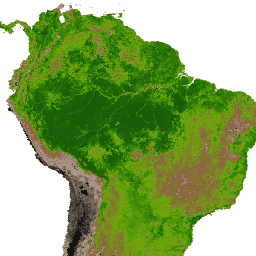Page Summary
-
This dataset has been superseded by MODIS/061/MOD13Q1.
-
The dataset provides Normalized Difference Vegetation Index (NDVI) and Enhanced Vegetation Index (EVI) values at a per-pixel basis.
-
The data is available from 2000-02-18 to 2023-02-02 with a 16-day cadence.
-
MODIS data acquired through the LP DAAC have no restrictions on subsequent use.

- Dataset Availability
- 2000-02-18T00:00:00Z–2023-02-02T00:00:00Z
- Dataset Provider
- NASA LP DAAC at the USGS EROS Center
- Cadence
- 16 Days
- Tags
Description
The MOD13Q1 V6 product provides a Vegetation Index (VI) value at a per pixel basis. There are two primary vegetation layers. The first is the Normalized Difference Vegetation Index (NDVI) which is referred to as the continuity index to the existing National Oceanic and Atmospheric Administration-Advanced Very High Resolution Radiometer (NOAA-AVHRR) derived NDVI. The second vegetation layer is the Enhanced Vegetation Index (EVI) that minimizes canopy background variations and maintains sensitivity over dense vegetation conditions. The EVI also uses the blue band to remove residual atmosphere contamination caused by smoke and sub-pixel thin cloud clouds. The MODIS NDVI and EVI products are computed from atmospherically corrected bi-directional surface reflectances that have been masked for water, clouds, heavy aerosols, and cloud shadows.
Documentation:
Bands
Pixel Size
250 meters
Bands
| Name | Units | Min | Max | Scale | Pixel Size | Wavelength | Description | ||||||||||||||||||||||||||||||||||||||||||||||||||||||||||||||||||||||||||||||||||||||||||||
|---|---|---|---|---|---|---|---|---|---|---|---|---|---|---|---|---|---|---|---|---|---|---|---|---|---|---|---|---|---|---|---|---|---|---|---|---|---|---|---|---|---|---|---|---|---|---|---|---|---|---|---|---|---|---|---|---|---|---|---|---|---|---|---|---|---|---|---|---|---|---|---|---|---|---|---|---|---|---|---|---|---|---|---|---|---|---|---|---|---|---|---|---|---|---|---|---|---|---|---|
NDVI |
-2000 | 10000 | 0.0001 | meters | None | Normalized Difference Vegetation Index |
|||||||||||||||||||||||||||||||||||||||||||||||||||||||||||||||||||||||||||||||||||||||||||||
EVI |
-2000 | 10000 | 0.0001 | meters | None | Enhanced Vegetation Index |
|||||||||||||||||||||||||||||||||||||||||||||||||||||||||||||||||||||||||||||||||||||||||||||
DetailedQA |
meters | None | VI quality indicators |
||||||||||||||||||||||||||||||||||||||||||||||||||||||||||||||||||||||||||||||||||||||||||||||||
sur_refl_b01 |
0 | 10000 | 0.0001 | meters | 645nm | Red surface reflectance |
|||||||||||||||||||||||||||||||||||||||||||||||||||||||||||||||||||||||||||||||||||||||||||||
sur_refl_b02 |
0 | 10000 | 0.0001 | meters | 858nm | NIR surface reflectance |
|||||||||||||||||||||||||||||||||||||||||||||||||||||||||||||||||||||||||||||||||||||||||||||
sur_refl_b03 |
0 | 10000 | 0.0001 | meters | 469nm | Blue surface reflectance |
|||||||||||||||||||||||||||||||||||||||||||||||||||||||||||||||||||||||||||||||||||||||||||||
sur_refl_b07 |
0 | 10000 | 0.0001 | meters | 2130nm/2105 - 2155nm | MIR surface reflectance |
|||||||||||||||||||||||||||||||||||||||||||||||||||||||||||||||||||||||||||||||||||||||||||||
ViewZenith |
deg | 0 | 18000 | 0.01 | meters | None | View zenith angle |
||||||||||||||||||||||||||||||||||||||||||||||||||||||||||||||||||||||||||||||||||||||||||||
SolarZenith |
deg | 0 | 18000 | 0.01 | meters | None | Solar zenith angle |
||||||||||||||||||||||||||||||||||||||||||||||||||||||||||||||||||||||||||||||||||||||||||||
RelativeAzimuth |
deg | -18000 | 18000 | 0.01 | meters | None | Relative azimuth angle |
||||||||||||||||||||||||||||||||||||||||||||||||||||||||||||||||||||||||||||||||||||||||||||
DayOfYear |
1 | 366 | meters | None | Julian day of year |
||||||||||||||||||||||||||||||||||||||||||||||||||||||||||||||||||||||||||||||||||||||||||||||
SummaryQA |
meters | None | Quality reliability of VI pixel |
||||||||||||||||||||||||||||||||||||||||||||||||||||||||||||||||||||||||||||||||||||||||||||||||
Terms of Use
Terms of Use
MODIS data and products acquired through the LP DAAC have no restrictions on subsequent use, sale, or redistribution.
Citations
Please visit LP DAAC 'Citing Our Data' page for information on citing LP DAAC datasets.
DOIs
Explore with Earth Engine
Code Editor (JavaScript)
var dataset = ee.ImageCollection('MODIS/006/MOD13Q1') .filter(ee.Filter.date('2018-01-01', '2018-05-01')); var ndvi = dataset.select('NDVI'); var ndviVis = { min: 0, max: 8000, palette: [ 'ffffff', 'ce7e45', 'df923d', 'f1b555', 'fcd163', '99b718', '74a901', '66a000', '529400', '3e8601', '207401', '056201', '004c00', '023b01', '012e01', '011d01', '011301' ], }; Map.setCenter(6.746, 46.529, 2); Map.addLayer(ndvi, ndviVis, 'NDVI');